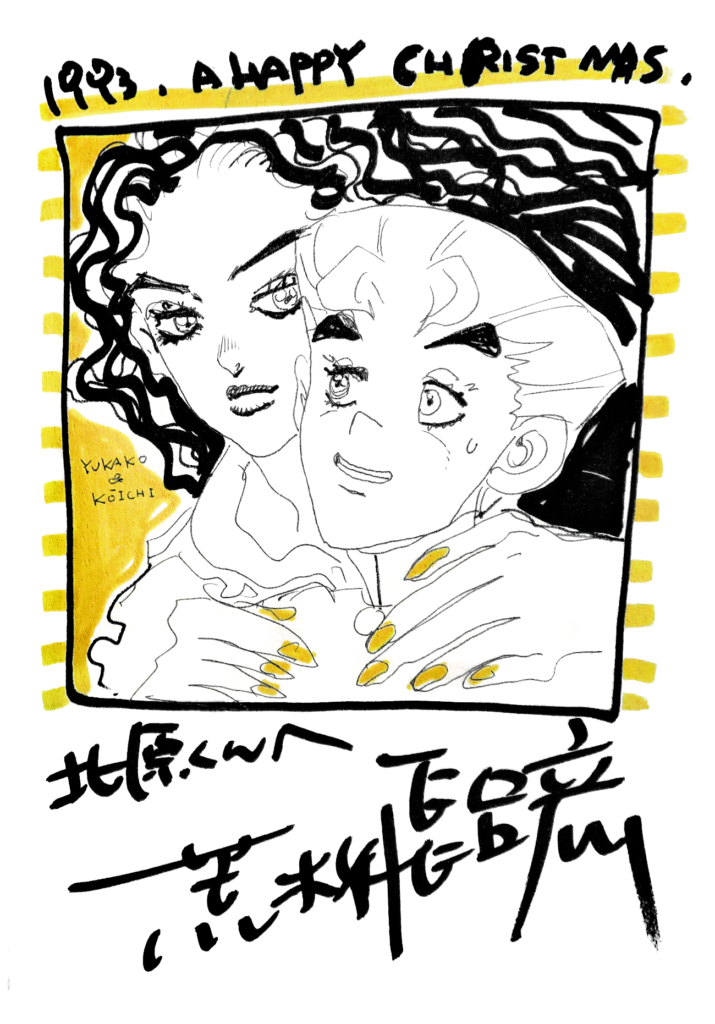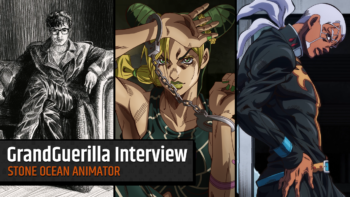We conducted an interview with Kouji Kitahara, a Japanese illustrator and former manga artist who worked as an assistant on JoJo’s Bizarre Adventure for Hirohiko Araki during Stardust Crusaders and Diamond is Unbreakable.
Unfortunately since Kitahara isn’t a fan of the series, he couldn’t answer many of our questions. However, he provided valuable insight on what kind of person Araki is and how it was like working for him.
About Kouji Kitahara
Kouji Kitahara (北原 功士) is a Japanese illustrator and former manga artist. He was inspired by horror books and illustrations of Ishihara Gojin, a prolific Japanese painter and illustrator known for his science fiction and horror art. He published the manga Sound of Footsteps (足音) in the January 1987 issue of Horror House magazine when he was a teenager.
In the 2010s, he decided to abandon being a manga artist and switched to doing illustrations. Kitahara’s work has appeared in magazines such as “Eiga Hiho”, as well as in his self-published collections. Kitahara’s artwork can be purchased on his BOOTH page here (NSFW).
Full Interview with Kouji Kitahara
When did you start working under Araki-sensei and for how long?
It might have been in 1990. I worked as a drawing staff member on JoJo for almost 5 years.
I loved the detailed backgrounds in Stardust Crusaders, especially with how you showed the different architecture and real landmarks in cities such as Calcutta or Cairo. Were these backgrounds drawn by assistants? What sort of images or books did you use as reference?
I believe they were drawn by Kei Sanbe-sensei, one of the staff members at the time. We used all kinds of things as references, such as history books and foreign photo books.
Which fight was your favorite in Part 3 or favorite to work on?
I don’t have a specific one. Sorry.
What kind of person was Araki-sensei? What was your first impression of him?
Even when the staff was taking a break or when the work was finished, he would be drawing pictures by himself. The most significant and valuable thing that I learned from Araki-sensei was his attitude towards drawing, and it still has a huge influence on me to this day. I was the kind of person who didn’t draw pictures exactly according to Araki-sensei’s instructions, but nevertheless he would still entrust me to do touch-ups on the art to a certain extent, and I think that’s because of the faith he had in his own work.
On his days off, he did things like watching movies or reading books, but was always active in creating his works. I think we’re alike in that way, so I felt comfortable around him. Since we liked the same movies, we’d often talk about movies together during work. He wouldn’t talk to the staff when he was absorbed in his work, but when he had time to breathe, he was the kind of person to talk to us like friends.
Although he sometimes gave us strict instructions for drawing, I think he’s basically a calm and gentle person. At the time, I was part of JoJo’s drawing staff, but I also was working on getting my own manga serialized in a magazine. There was no time to sleep and I once showed up 8 hours late for work at the JoJo studio, but he wasn’t mad and forgave me. Now that I think about it, he might have realized that I had my own work to deal with.
Do you still read JoJo? What part is your favorite?
I don’t read it now. Don’t particularly have a favorite part.
What’s your favorite horror scene that Araki-sensei drew?
There isn’t one specifically.
Who is your favorite JoJo character?
Don’t have one.
Araki-sensei talks a lot about his music tastes. Did he also do that during work?
It seemed like there were some staff members who were well-acquainted with music who he would speak to. I only talked about movies and novels.
How was it like to work with Araki-sensei?
He had a particular approach in regards to drawing pictures, which left a big impression on me.
If you had to point out one thing that you gained from this experience, what would that be?
My attitude as an artist.
We saw that you are credited on the last page of the JoJo 6251 art book. What did you draw in it?
I think I colored the emblem on the back cover, but I don’t remember exactly. The art book merely listed the names of people who were on the staff at the time it released, not specifically the names of those who were involved in the color illustrations. I think most of the colors were done by Kei Sanbe-sensei.
I don’t remember most of what I drew for JoJo and I don’t particularly like or read the JoJo manga, so I’m sorry that I can’t answer most of your questions.
I remember drawing the wooden doll Stand when it was published in the magazine, but I didn’t like how it came out at that time, so I redrew it. I remember that Araki-sensei looked at my corrected version and asked what was different from the one in the magazine. I guess it did end up looking the same as it did back then! But personally, I had tried redrawing the Stand with clearer lines.
荒木先生のもとで働き始めたのはいつからですか?いつまでですか?
1990年だったと思います。ジョジョの作画スタッフを5年近くやりまして。
第3部には、カルカッタやカイロなどの建築物や現実にあるランドマークが細かく描かれていて、とても気に入りました。これらの背景はアシスタントが描いたのでしょうか?また、どのような画像や本などを参考にされたのでしょうか?
当時のスタッフの一人である三部けい先生だと思います。歴史書や海外の写真集などあらゆるものを参考にしています。
第3部の一番好きなスタンドバトルはどれですか?どのスタンドバトルに携わるのが一番好きでしたか?
特にありません。すみません。
荒木先生はどのような方ですか?第一印象は?
スタッフが休憩している時や仕事が終了した時にも御一人で絵を描いていました。荒木先生に学んだ事でもっとも大きく価値ある事は、そういった作画に向かう姿勢で、現在も大きな影響を受けています。僕は荒木先生の指示通りに作画をしないような人間でしたが、絵のタッチなどある程度こちらに任せてくれるような方で、ご自分の仕事に自信があるからできる事なのだろうと思っていました。
休みの日は、映画を観たり読書をしたり、常に作品作りのための行動をとっておられました。その点は僕も同様でしたので、親近感がありました。同じ映画好きだったので作業中、よく映画の話をさせていただきました。作画に没頭している時はスタッフとの会話はしない人でしたが、気持ちに余裕がある時などは、友人のように話しかけてくれる人でした。
作画において厳しい指示をいただいた事もありましたが、基本的にはおだやかで優しい方だと思います。当時、JOJOの作画スタッフでしたが、ある雑誌で自分の漫画連載もやっていたため、眠る時間が無く、JOJOの仕事に8時間遅刻した事がありましたが、怒る事も無く許してくれたのは、僕が自分の仕事を持っていた事に気づいていたのかも知れないと今は思います。
今でもジョジョを読んでいますか?何部が一番好きですか?
読んでいません。特に好きなシーズンはありません。
荒木先生が描いたホラーシーンは、どれが一番好きですか?
特にありません。
一番好きなジョジョのキャラクターは誰ですか?
いません。
荒木先生は音楽についてよく話すそうですが、仕事中もそうだったのでしょうか?
音楽に詳しいスタッフとは話す事もあったようです。僕は映画や小説の話ばかりしてました。
荒木先生と一緒に働いて、いかがでしたか?
絵を描くという事に関して、特にその姿勢の面で、大きな影響を受けました。
このアシスタントの経験から得たものを1つ選ぶとしたら、何を選びますか?
絵描きとしての姿勢。
JoJo 6251のクレジットのページに北原先生の名前が書いてありますが、特に何を描かれましたか?
裏表紙のエンブレムを塗ったような記憶がありますがよく覚えてません。画集には発売当時にスタッフだった人の名前が書いてあるだけでカラーイラストに関わっていない人の名前も載っていますよ。カラーはほとんど三部けい先生が塗ってたと思います。
ジョジョの仕事で何を描いたかは殆ど記憶になくジョジョという漫画も特に好きでもなく読んでもいないのでご質問に殆ど答えられずすみません。
木の人形のスタンドは雑誌掲載時に描きましたが気に入らずもう一回書き直させてもらったので覚えています。荒木先生は直したものを見て雑誌掲載時と何が違うんだと言っていたのでそれも記憶にあります。ぽくなってしまいましたね!僕としては明瞭な線に書き直しまさた。
Kitahara’s answers were translated to English by Vish and Irene. Thanks to BlueCombElephant for revisions.
For more information about Kitahara including memorable stories he shared about his time working for Araki, see his wiki page or check his Twitter!







